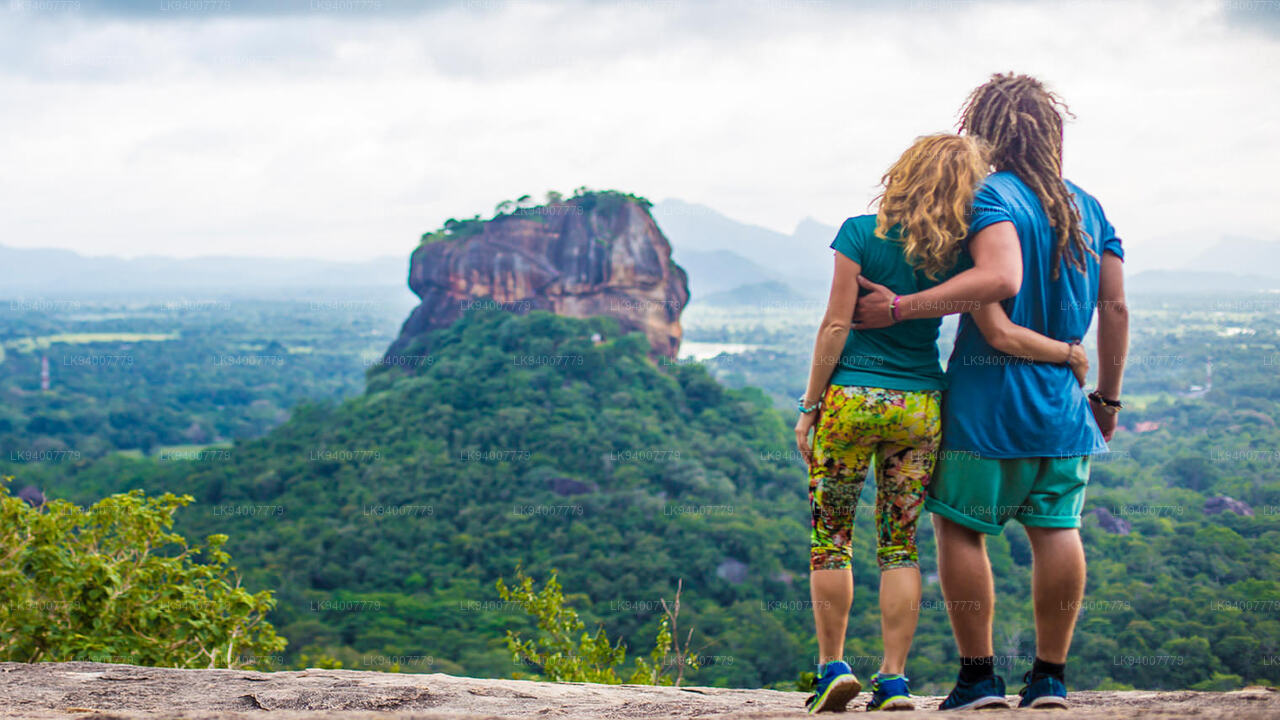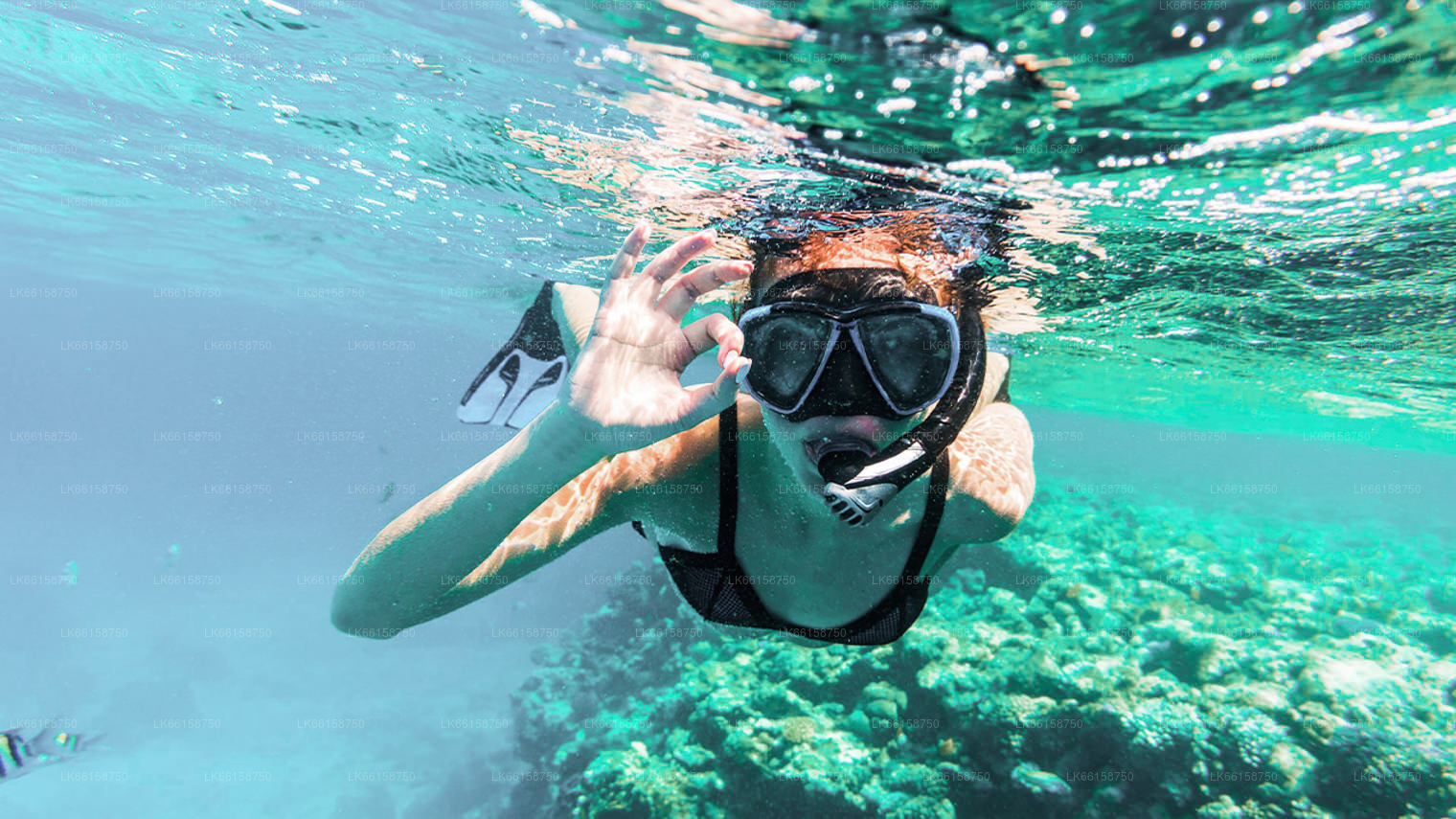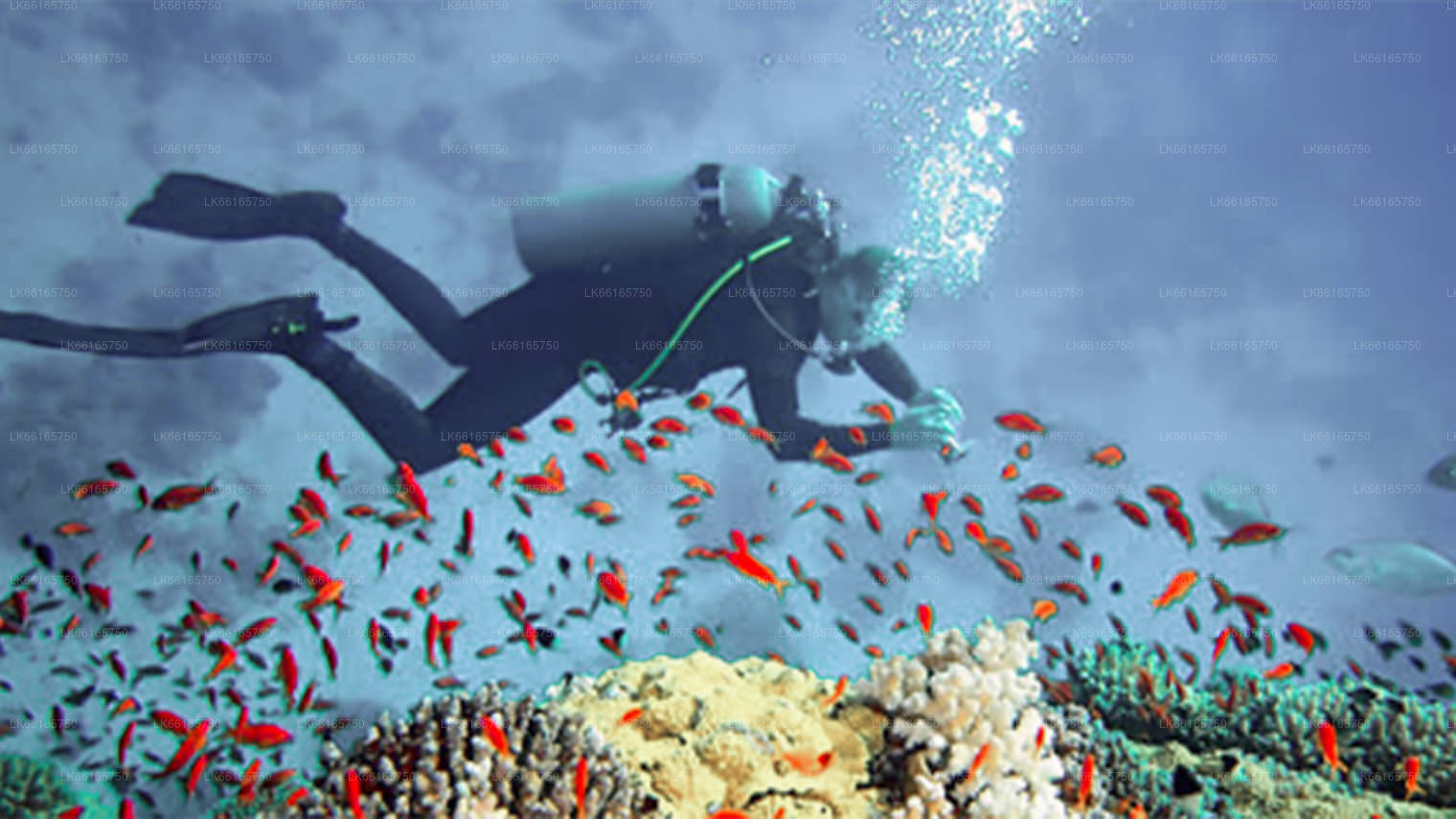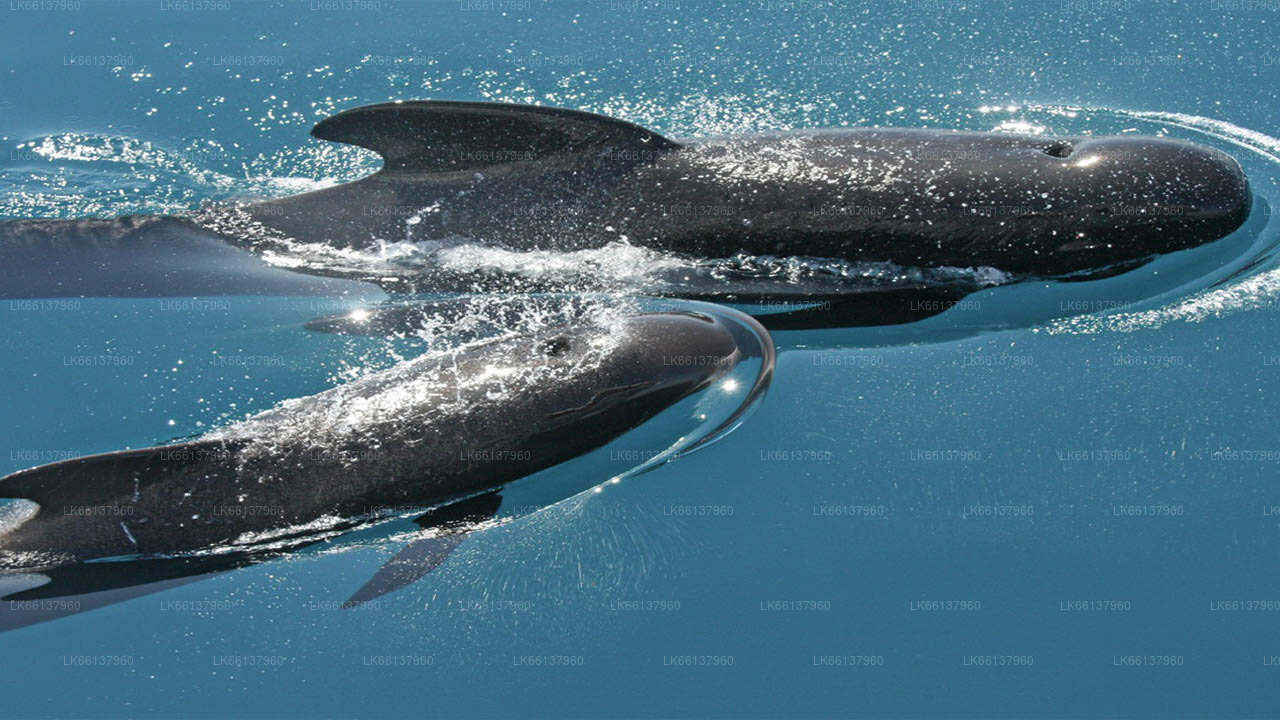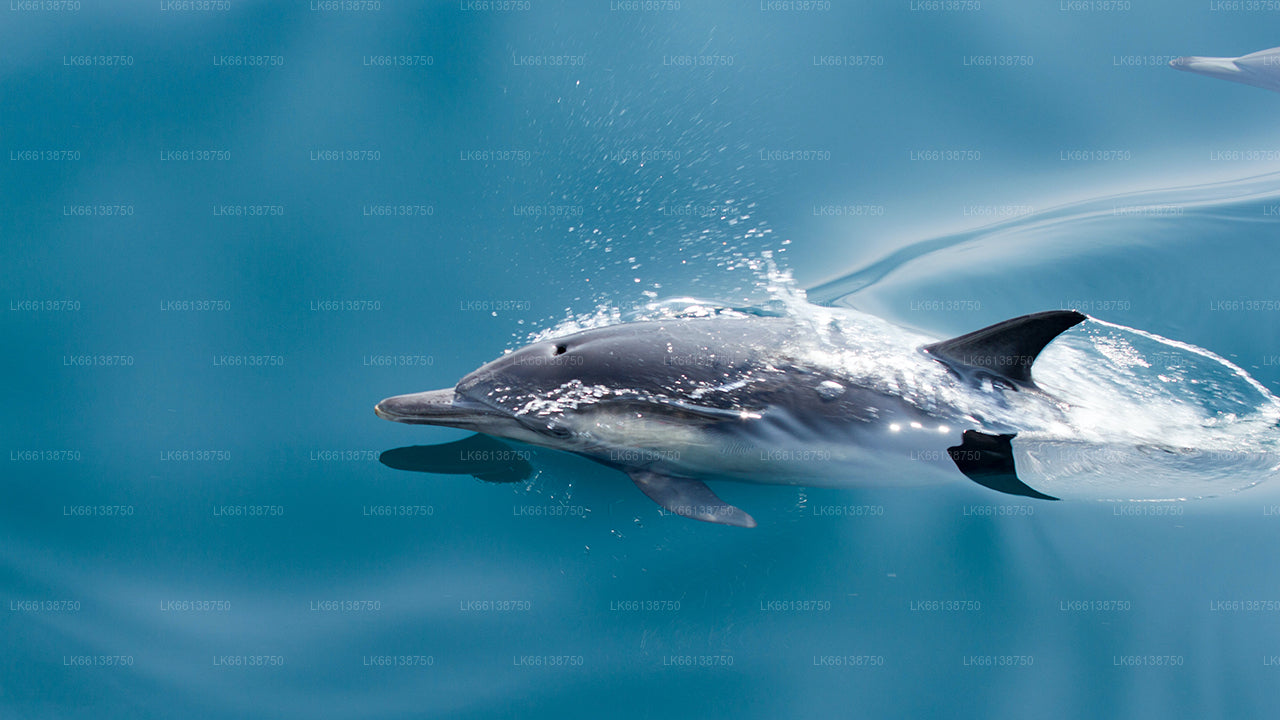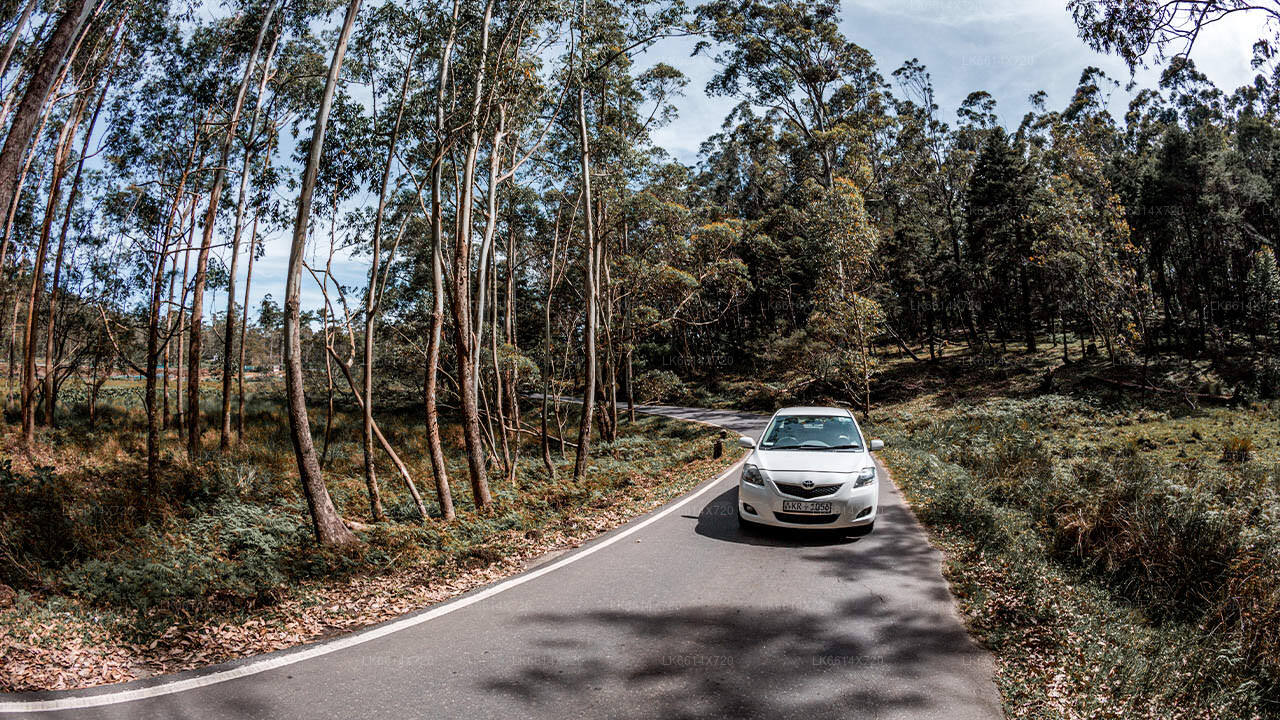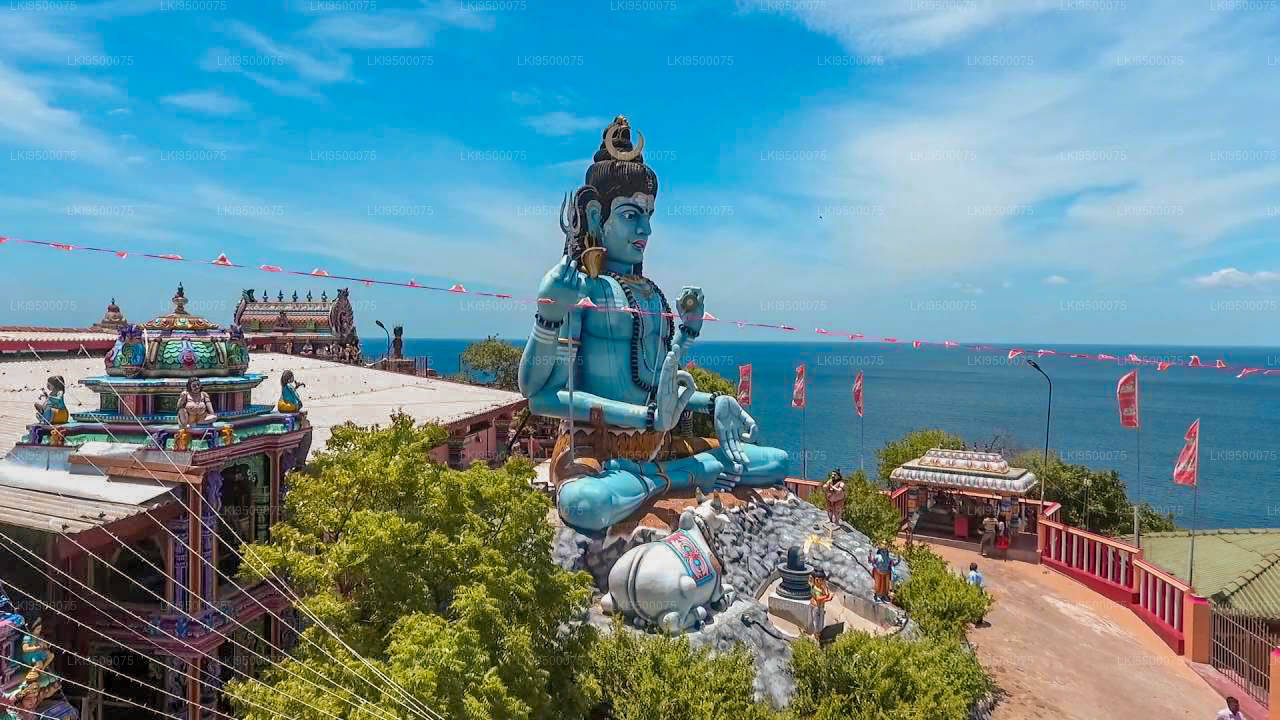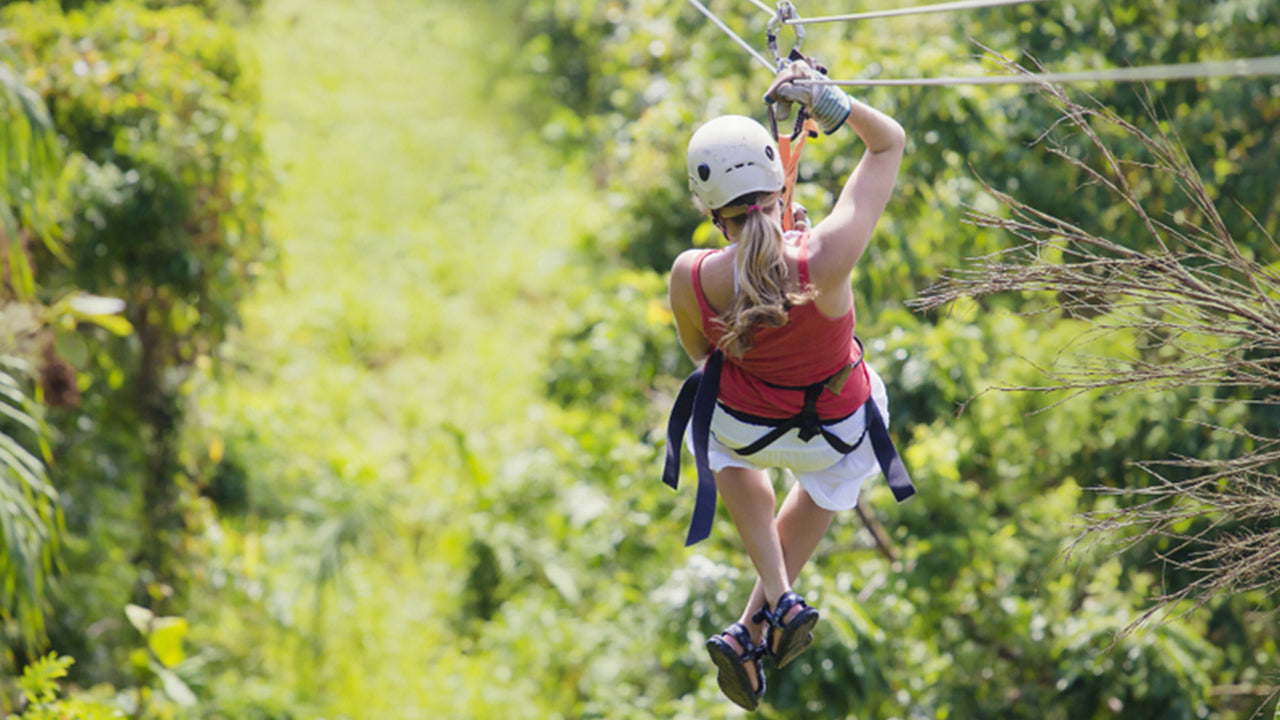
Trincomalee City
Trincomalee, located on the northeast coast of Sri Lanka, boasts a natural deep-water harbor and pristine beaches. Rich in history, it features landmarks like the ancient Koneswaram Temple. The city's diverse marine life and vibrant culture make it a captivating destination for tourists and historians alike.
Koneswaram Temple
Koneswaram temple of Trincomalee (Tamil: திருக் கோணேச்சரம் கோயில்) or Thirukonamalai Konesar Temple – The Temple of the Thousand Pillars and Dakshina-Then Kailasam is a classical-medieval Hindu temple complex in Trincomalee, a Hindu religious pilgrimage centre in Eastern Province, Sri Lanka. The most sacred of the Pancha Ishwarams of Sri Lanka, it was built significantly during the reign of the early Cholas and the Five Dravidians of the Early Pandyan Kingdom on top of Konesar Malai, a promontory overlooking Trincomalee District, Gokarna bay and the Indian Ocean. Its Pallava, Chola, Pandyan and Jaffna design reflect a continual Tamil Saivite influence in the Vannimai region from the classical period. The monument contains its main shrine to Shiva in the form Kona-Eiswara, shortened to Konesar. Connected at the mouth of the Mahavilli Ganga River to the footprint of Shiva at Sivan Oli Padam Malai at the river's source, the temple symbolically crowns the flow of the Ganges River from Shiva's head of Mount Kailash to his feet.
Developed from 205 BC, the original kovil combined key features to form its basic Dravidian temple plan, such as its thousand pillared hall – "Aayiram Kaal Mandapam" – and the Jagati expanded by King Elara Manu Needhi Cholan. Regarded as the greatest building of its age for its architecture, elaborate sculptural bas-relief ornamentation adorned a black granite megalith while its multiple gold plated gopuram towers were expanded in the medieval period. One of three major Hindu shrines on the promontory with a colossal gopuram tower, it stood distinctly on the cape's highest eminence.
The journey for pilgrims in the town begins at the opening of Konesar Road and follows a path through courtyard shrines of the compound to the deities Bhadrakali, Ganesh, Vishnu Thirumal, Surya, Raavana, Ambal-Shakti, Murukan and Shiva who presides at the promontory's height. The annual Koneswaram Temple Ther Thiruvilah festival involves the Bhadrakali temple of Trincomalee, the Pavanasam Theertham at the preserved Papanasuchunai holy well and the proximal Back Bay Sea (Theertham Karatkarai) surrounding Konesar Malai.
The Sinhalese king Gajabahu II who ruled Polonnaruwa from 1131 to 1153 AD is described in the Konesar Kalvettu as a devout worshipper of Lord Shiva and a benefactor of the temple of Konamalai. He spent his last days in the associated Brahmin settlement of Kantalai.
The complex was destroyed in colonial religious attacks between 1622 and 1624 and a fort was built at the site from its debris. A 1632 built temple located away from the city houses some of its original idols. Worldwide interest was renewed following the discovery of its underwater and land ruins, sculptures and Chola bronzes by archaeologists and Arthur C. Clarke. It has been preserved through restorations, most recently in the 1950s. Granted ownership of villages in its floruit to form the Trincomalee District, Trincomalee village is located on the cape isthmus within the compounds. Revenue from the temple provides services and food to local residents.
Koneswaram has many strong historical associations. The shrine is described in the Vayu Purana, the Konesar Kalvettu and Tevaram hymns by Sambandhar and Sundarar as a Paadal Petra Sthalam along with its west coast Ishwaram counterpart Ketheeswaram temple, Mannar, and was praised for its tradition by Arunagirinathar upon his visit. The Dakshina Kailasa Puranam and Manmiam works note it as Dakshina/Then Kailasam (Mount Kailash of the South) for its longitudinal position and pre-eminence, it lies directly east of Kudiramalai west coast Hindu port town, while it is the easternmost shrine of the five ancient Ishwarams of Shiva on the island.
Mentioned as a widely popular bay temple of the island in the Mahabharata, Ramayana and Yalpana Vaipava Malai, the Mattakallappu Manmiam confirms its sacred status for all Hindus. Kachiyappa Sivachariar's Kanda Puranam compares the temple to Thillai Chidambaram Temple and Mount Kailash in Saivite esteem. Konesar Malai may have been the site where Yoga originated; some scholars have suggested that the worship of the almighty god Eiswara on the promontory is the most ancient form of worship existing.
History
Origins and date of establishmentThe construction time of Koneswaram has been estimated by comparison between carved reliefs on the temple's ruins, literature on the shrine and the inscriptions commonly used in royal charters from the 5th to 18th centuries. Koneswaram was likely founded before 400 B.C., although its exact date of birth remains vague. The evidence extant attests to the shrine's classical antiquity. Construction of Hindu temples was made possible due to the prevalent faith amongst the locals and mercantile communities in the region during the Sangam period
Kaviraja Varothiyan's Tamil poem inscribed on the Konesar Kalvettu, the 17th-century stone inscription chronicle of the temple, gives the shrine's date of birth as circa 1580 B.C. Archaeologists point to its initial phase consisting of a rock cave, multilayered brick shrine style popularly constructed to Tamil deities of a range of faiths during the Sangam period (see Religion in ancient Tamil country).
Contemporary historians such as S. Pathmanathan and Paul E. Peiris suggest Koneswaram temple has a recorded history from 300, when it finds mention in the Vayu Purana. Peiris notes that Koneswaram was one of the five recognised Iswarams of the Hindu deity Shiva in Lanka before the sixth century B.C.; a widely famous centre of deity worship long before the arrival of the mythical exile Vijaya to the island, attributed to the period 543—505 B.C. Koneswaram is the easternmost shrine of the Iswarams, the others being Naguleswaram (Keerimalai), Thiruketheeswaram (Mannar), Munneswaram (Chilaw) and Tenavaram (Tevan Thurai). The historian Diogo de Couto of the 16th century adds Ramanathaswamy Temple, Rameswaram to this group of principle temples in the region most revered on the Indian subcontinent
Other writers point to the worship of Eiswara by mythical royals on the island like Kuveni before the exile's arrival.Pathmanathan differs from Peiris in his view on the shrine's birth however, stating that Koneswaram temple was most likely established as a Hindu shrine by the mercantile communities that frequented the island from the fourth-century B.C. Kalinga region in India, where another temple dedicated to Shiva in the form Gokarnasvamin at Mahendra mountains is found. The Yalpana Vaipava Malai, an 18th-century Tamil chronicle connects the figure Vijaya and seven hundred of his followers to the shrine, stating they extensively repaired the five Iswarams upon their arrival to the island, before mixing with native tribes on the island forming matrimonial links with the Tamil kingdom through Pandyan queens. The Encyclopædia Britannica currently appears to follow this view, although in volume 10 of the encyclopedia, printed in 1974, the shrine's establishment is attributed to Tamil migrants. Encyclopedia Americana and New International Encyclopedia note that early Tamil rulers erected the temple of a thousand columns on the hilltop
King Ellalan Manu Needhi Cholan in 205 B.C. and the prince Kulakottan of the Chola Dynasty extensively renovated the Koneswaram temple and the Kantalai Tank, responsible for irrigating plains belonging to the shrine. The latter's reign is alternatively attributed to between 1580 B.C. and 1250. Due to royal patronage by various Tamil dynasties from the early classical to medieval era, the temple flourished in the early centuries of the First Millennium. Hindus built at least three great stone temples with gopura on Swami Rock during Koneswaram's zenith, one to Vishnu-Thirumal, one to the goddess and the principal temple of the complex to Lord Shiva at its highest eminence.
Location and layout
Trincomalee Koneswaram temple compoundsThe shrine was known to Europeans as the Pagoda of Trincomalee – Temple of a Thousand Columns. The main shrine was built upon the jagati while its thousand pillared hall was the Aayiram Kaal Mandapam – a distinctly thousand pillared platform close to the vimana of the koil that forms a distinct part of the site plan of classical Dravidian temple architecture. Ruins of this feature at Koneswaram indicate that the hall was a structural addition erected by Pallava artisans, dated between 537 and 668. It formed one of the nine prakara or major courtyard compounds of the Koneswaram complex. Two other temples were prominent compound monuments on the promontory, containing prolific gopura structures over the shrines built to Vishnu-Thirumal and the goddess Ambal-Shakti. Together, they became known as the Three Pagodas of Thirukonamalai. A site plan by De Quieroz states: "On the first rise to the summit of the rock was a Pagoda, another at mid-ascent, and the principal one of them all at the highest eminence, visited by a concourse of Hindus from the whole of India." In his dispatch to Philip III, King of Portugal, Constantine described: "The land of the Pagoda is 600 fathoms long (1.2 km) and 80 feet at its broadest, narrowing to 30 feet." The complex stretches across Konesar Road off the promontory, and includes shrines to Ganesh, Murukan and Bhadrakali. Koneswaram of Konesar Malai is located 152 kilometres (94.4 mi) directly east from Kudiramalai, the ancient royal district and southern pearl-bank emporium of the Thiru Ketheeswaram temple, Mannar. Koneswaram lies on a straight diagonal path connected to Ketheeswaram and another former Jaffna temple and Paadal Petra Sthalam Ramanathaswamy Temple, Rameswaram. This pilrimage path of 225 km (140 mi) is often traversed by foot according to Hindu custom. The complex also lies on exactly the same longitude as Mount Kailash.
Deities of the complexIn line with custom of Tamil Hindu temple compounds, the complex houses shrines to several deities. Koneswaram is the easternmost shrine of the 5 ancient Iswarams of Lord Shiva on the island, the others being Naguleswaram (Keerimalai), Thiruketheeswaram (Mannar), Munneswaram (Chilaw) and Tenavaram (Tevan Thurai). Koneswaram has attracted thousands of pilgrims from across Asia, its Shiva shrine mentioned in the Ramayana and the Mahabharata written from 400 to 100 B.C. describe at length its attraction to pilgrims from many countries and from 600 to 660, it has been glorified as one of 275 Shiva Sthalams, or holy Shiva dwellings on the continent in Tevaram. Swami Rock is heralded as a Shiva Upa Peetha (base) of Lanka in the Sivacharita, a Sanskrit work in praise of Shiva, and subsequent manuscripts of the Pithanirnaya (Maha Piitha Nirupana) as a general Sakta Peetha of Lanka with a temple of the compounds dedicated to the goddess Indraksi Devi and a male deity Raksasesvara – a reference to Ravana. Kullakottan reconstructed the Three Pagodas of Thirukonamalai, the other two dedicated to Vishnu-Thirumal and that of the Mother-Goddess (Tirukkamakkottam – a consort of Shiva) on the promontory over a far greater area than at present. This latter temple to the goddess – Ambal/Uma/Shakti/Shankari Devi – was one of the 18 Maha Shakthi Peethas, those Shakti Peethas consecrated to the goddess which are mentioned in the Ashta Dasa Shakthi Peetha Stotram by the Hindu philosopher Adi Shankara (788—820). The Vishnu-Thirumal temple was likely the first temple encountered on the promontory – and is mentioned in Oud en Nieuw Oost-Indiën written in 1726 by François Valentijn. The temple closest to the sea end was likely that dedicated to the goddess, where the current reconstructed Shiva temple stands. Smaller shrines within the complex to Ganesh, Durga, Murukan, Agastya, and the Navagraha including the sun god Surya would have been customary near the main shrine in the centre to Shiva – the Murukan shrine is hailed at large in the Thiruppugazh series of Arunagirinathar. The temple to Bhadrakali is located further along in the complex inland along Konesar Road, benefitted from Rajendra Chola I. The Kali temple is mentioned in the book Birds of Prey (1997) by Wilbur Smith, set in the 1660s. The Thirukonasala Mahatyam, describing the origins of the world, Lanka and Koneswaram based on puranic legends is now lost. The historical literature Mattakallappu Manmiyam (Batticaloa Manmiyam) that chronicles the history of Tamil settlement in Batticaloa, follows the Dakshina Kailasa Puranam and Dakshina Kailasa Manmiam in describing Koneswaram as one of the nine most important and sacred sites in the world for all Hindus
LegendsAccording to one Hindu legend, Shiva at Koneswaram was worshipped by Indra, king of the gods. King Ravana of the epic Ramayana and his mother are believed to have worshiped Lord Shiva in the sacred lingam form at Koneswaram circa 2000 B.C.; the cleft of Swami Rock is attributed to Ravana's great strength. According to this tradition, his father-in-law Maya built the Ketheeswaram temple in Mannar. Ravana is believed to have brought the swayambhu lingam in the temple to Koneswaram, one of sixty-nine such lingams he carried from Mount Kailash.
With the legend of the smiling infant, James Emerson Tennent describes "one of the most graceful" of the Tamil legends connected to the Temple of the Thousand Columns atop Swami Rock. An oracle had declared that over the dominions of one of the kings of the Deccan impended a great peril which could only be averted by the sacrifice of his infant daughter, who was committed to the sea on an ark of sandalwood, eventually reaching the island, south of Trincomalee at a place that in the mid 19th century was still called ’’Pālanakai’’ (smiling infant), current Panagai. After being adopted by the king of the district, she succeeded over his dominions. Meanwhile, the Hindu prince Kullakottan, having ascertained from the Puranas that the rock of Trincomalee was the holy fragment Koneiswara parwatia of the golden mountain of Meru, hurled there during a conflict between gods, arrived at Swami Rock and constructed a temple of Shiva. The princess, hearing of his arrival, initially dispatched an army to expel him, but ended up marrying the prince to end the war, and later attached vast rice fields of Thampalakamam and built the great Kantalai tank to endow the temple and irrigate the surrounding plain. Upon her death, the prince shut himself inside the pagoda of Swami rock, and was later found translated into a golden lotus on the Shiva altar
The Dakshina Kailasa Manmiam, a chronicle on the history of the temple, notes that the Sage Agastya proceeded from Vetharaniam in South India to the Parameswara Shiva temple at Tirukarasai – now in ruins – on the bank of the Mavilli Kankai before worshipping at Koneswaram; from there he went to Maha Tuvaddapuri to worship Lord Ketheeswarar and finally settled down on the Podiya Hills.
Dutch legends connected with the Hindu pillar from the ruins on Swami Rock concern an inscription found engraved on the re-erected monument dated to 1687. The inscription reads: "Tot gedaghtenis van Fran- cina van Reede, lofr. van Mydregt, dezen A° 1687 M April opgeregt", or in English : " This has been erected on the 24th April 1687 to commemorate Francina van Reede, Lady of the Manor of Mydrecht". The Dutch Governor of Ceylon Gustaaf Willem van Imhoff mentions the pillar in his diaries of 1738, visiting "Pagoodsberg" or "Pagoda Hill" on a trip from Jaffna to Trincomalee to meet Vanniar chiefs in the region. There he notes on his visit on 31 May, the "name of Francina van Reede, daughter of the late Commissaris Generaal van Reede was found cut on a shaft, with the year 1687, which shows that she too came as far as this. Nothing else worth mentioning...". The girl's father was Hendrik van Rheede, commander of Jaffna during Dutch Ceylon, and sailed from Trincomalee to Point Pedro on 23 April 1687. Historian Jonathan Forbes writing in 1810 in his book Eleven Years in Ceylon describes the pillar as a memorial to Francina's suicide, having flung herself off the edge of the cliff into the sea having seen her lover, a young Dutch officer to whom she was betrothed, sail away to Holland. Some historians describe this story as a conflation with practices that Queyroz claimed occurred with pilgrims at the site as idol worshiping sailors venerated the site from the sea. Historical records from closer to the period indicate Francina van Reede remarried in 1694. Writers describe the intentions of the person who re-erected the old Hindu pillar and carved the inscription on it as being to commemorate Francina having climbed the crag to wave goodbye to her father as he sailed past, and a token of human affection. Ravana's Cleft is also known as Lover's Leap in reference to this legend.
Another tradition holds that during his rule in 113 A.D., King Gajabahu I marched from his southern strongholds to the Konesar Kovil with the intention of demolishing it and converting it to a Buddhist temple. When nearing the Kantalai tank, he is believed to have been miraculously cured of his blindness by a Hindu, and henceforth converted to Hinduism. The tank is said to be named on this account Kandalai meaning "eye grows" in Tami
FestivalsThe Koneswaram temple is well known for its celebration of the traditional Ther chariot festival, the Navaratri and Sivarathri functions. The Ther Chariot Festival lasts for twenty two days in April and focuses on preparing the deities and the community for Puthandu, the Tamil New Year. Navaratri lasts for nine days and is dedicated to various aspects of the presiding goddess, whereas Sivarathri is dedicated to Siva. Devotees visit the temple to attend the daily pujas and make their offerings. Booths are erected outside for the sale of food, drink, brassware, pottery, cloth and holy images. These functions primarily attract Hindus to the temple.
The main Thirukoneswaram Ther Thiruvilah Festival, the twenty-two-day annual chariot festival begins with the hoisting of the temple Nandi flag. This is followed by temple processions of Lord Konesar and his consort Mathumai Ambal, installed and pulled in an ornate chariot temple car while deities Pillayar and Murugan with his two consorts Valli and Theivayanai are taken ahead in two other decorated chariots. This is conducted throughout Trincomalee district, and follows Kulakottan's stone scriptures detailing how Hindus in Tamil villages like Sambaltivu, lands which historically belonged to the temple, are entitled to hold poojahs as their Upayam during the annual festival period. Until April 1624 the Koneswaram Ther Festival occurred around Puthandu in April annually with five chariots and this tradition was reintroduced in April 2003, three hundred and seventy nine years later. The water-cutting Theertham Thiruvilah festival (holy bath) takes place annually in the centuries-old Papanasachunai holy well (Papanasam Theertham) on Swami Rock during the Ther festival period. The deity and other holy artefacts are bathed in the water of the well in the complex's sacred precincts. Devotees are sprayed with the holy water following the Theertham. The Theppath Thiruvilah Boat Festival consists of Lord Konesar and goddess Mathumai Ambal taken in a boat around the temple from Swami Rock via the Back Bay Sea to the Dutch Bay Sea. Religious discourses and cultural items take place throughout the night before Puthandu at the Dutch Bay Sea beach. Thereafter the deities are taken to the temple early morning the next day on Puthandu by road through the Fort Frederick entrance. The Trincomalee Bhadrakali Amman Temple and other Hindu temples have held their water-cutting Theertham festivals in the Back Bay Sea (Theertha Kadatkarai) for several centuries. The Koneswaram Poongavanam Festival – the Temple Garden Festival is held during this twenty-two-day festival period.
An annual three-day procession follows Maha Sivarathri Day, observed every year since 1951 following the rediscovery of the bronze idols in 1950. Occurring in three stages, on each day of the festival, the images of the chief deity Konesar, the presiding consort goddess Mathumai Amman, Ganesh and Murugan are brought from Swami Rock to the entrance of Fort Fredrick in decorated Ther temple cars before being paraded through the whole Periyakadai of the Trincomalee town. The chariot cars are pulled by devotees through a decorated route while singing hymns. Devotees hold Poorna kumbham outside their houses along the route and worship as the procession moves. On the second day of the festival there is a procession to the Pathirakalai Ambal Temple where the images are kept for the evening. On the final day of the festival, the large chariots are pulled back to Koneswaram along a route through Trincomalee, accompanied by traditional Nadeswaram and Thavil musicians
About Trincomalee District
Trincomalee is a port city on the east coast of Sri Lanka. The Bay of Trincomalee's harbour is renowned for its large size and security; unlike every other in the Indian Sea, it is accessible to all types of craft in all weathers. The beaches are used for surfing, scuba diving, fishing and whale watching. The city also has the largest Dutch fort in Sri Lanka. It is home to major Sri Lankan naval bases and a Sri Lankan Air Force base.
Most of the Tamils and Sinhalese believe that this place is sacred to them and they are the indigenous people of the area. Trincomalee and its environs have both Hindu and Buddhist sites of historical importance. These sites are sacred to the Hindus and Buddhists.
About Eastern Province
The Eastern Province is one of the 9 provinces of Sri Lanka. The provinces have existed since the 19th century but they didn't have any legal status until 1987 when the 13th Amendment to the 1978 Constitution of Sri Lanka established provincial councils. Between 1988 and 2006 the province was temporarily merged with the Northern Province to form the North-East Province. The capital of the province is Trincomalee. The Eastern province's population was 1,460,939 in 2007. The province is the most diverse in Sri Lanka, both ethnically and religiously.
Eastern province has an area of 9,996 square kilometers (3,859.5 sq mi).The province is surrounded by the Northern Province to the north, the Bay of Bengal to the east, the Southern Province to the south, and the Uva, Central and North Central provinces to the west. The province's coast is dominated by lagoons, the largest being Batticaloa lagoon, Kokkilai lagoon, Upaar Lagoon and Ullackalie Lagoon.







